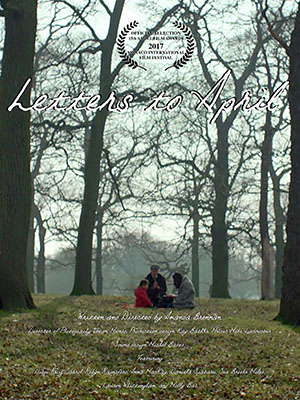 2017 Angel Film Awards - Monaco International Film Festival
2017 Angel Film Awards - Monaco International Film Festival 
THE ANGEL FILM AWARDS HONORING SCREENPLAY WRITERS
 
|
IN OFFICIAL SELECTION "LETTERS TO APRIL" (UK) WRITTEN BY AMANDA BRENNANBIO: Amanda Brennan is a Writer and Director of the movie ‘Letters to April’ (Women and History FF, Irish Short FF), Yes, but that’s not all, (Documentary. Runner up at Moondance 2016, Awareness FF 2016), in (2015) her movie Birthcloud won the Angel Film Awards Monaco for Best Supporting Actress, Best Score, Best Costume, Best Ensemble cast; (2014) another film Into the Forest (Brennan produced several short film include: Noose (2017) Walls Between Us (2017) Siobhan (2017) Dawn of the Deaf (Sundance 2017, Sitges/Spain, Fright Fest 2016) Healey’s House (London Film Festival 2016, Encounters, 2016 London Short film Festival 2017). Fangirl (Underwire, Aethetica 2016), The Befuddled Box of Betty Buttifint, (Feature) (East End Film Festival 2015 nominated for best Cinematography.) Beautiful Death (Oaxaca & Aesthetica.2012) Grace (Cambridge, Texas, Best Screen play,Tribeca.2012) Donkey(EP)(Winner of Best Short Film Reykjavik, and the Critics choice at Tribeca 2011). She is Principal Lecturer in Acting at Royal Central School of Speech and Drama in London and also works as a freelance acting coach, recent projects include The Visitor (2017) Colette (2017) Genius (2017), Journeys End (2017), Miss Peregrines Home for Peculiar Children (2016), The Night Of (2016), Dusky Paradise (2015), X + Y (2014) 10,000 Saints (2014) Enders Game,(2013)Hugo,(2012) Shakespeare Must Die (2010). She is the author or The Energetic Performer published in 2016 by Singing Dragon. "LETTERS TO APRIL" 'A Short Screenplay' WRITTEN BY AMANDA BRENNAN (UK) LOGLINE: (Genre: Historical Drama) 'Based on true events' To escape poverty a Mother temporarily places her infant in the care of the Catholic Church, years later when reunited she discovers the alarming truth of her child’s history. Short Synopsis: A daughter searches for her Mother over two decades. Set in 1978 the film flashes back to 1956 when April was placed in temporary care but tragically becomes part of the Child Migration Scheme sponsored by the British Government. Although the characters are fictional the story is based on true events. It explores the pain and loss of the separation, and ultimately the power of unconditional love. STORY OUTLINE: Letters to April begins in 1978 with a rushed family breakfast. Fran, the Mother and her two children Bella a 19 year old, feisty and fashionable, Antonio 21, stoic and witty, fleetingly exchange news before they go to work. Prior to leaving Fran collects the days mail and unexpectedly hears some news which immediately connects her with her buried past. She reads that her daughter April, who she temporarily placed in care in 1956, is wanting to reach her. The memory of a tearful goodbye on a door step brings both pain and immense shock, as this family secret had been locked tightly away. Fran opens a chest which contains the many letters she has written but not sent to her child, her intention is to put the letter away. She is briefly interrupted by Bella’s return home to collect a concert ticket, this moment creates a change, a reminder of the love she has for her children including April. As Fran reads some of the old correspondence the voice of April intercepts, she tells of how she has been searching and longing to find her real family. At a secluded location Mother and daughter exchange the bewildering news of how they were separated. Fran explains that due to extreme hard times Roberto, her husband, had taken a caretaker position away from home but the nature of the job meant the then 4 year old April could not go with them. Roberto had found a place run by the Church which would take care of the child for a short period, six months at the most then they would be reunited. Unbeknown to her parents April became a part of the Child Migration Scheme sponsored by the British Government between 1964 - 1962 and spend her childhood in Rhodesia. An immediate bond is recreated between Mother and Daughter and they begin to come to terms with their lost years. Fran informs her other children that they have a sister. Both Bella and Antonio struggle to accept the news and the actions of their parents but decide they would like to meet their sister. A family party is arranged where Fran shares the final piece of news that April has been in Rhodesia. On the door step April watches her siblings prepare for the party, she witnesses the joy of family life and suddenly remembers the last time she saw her parents as a small child, alone with her suitcase. In that moment she decides that it is best not to bring any disruption to what appears to be a harmonious life. The family are devastated that April has decided not to come to the party. Feeling rejected and confused Bella, Roberto and Fran each reflect on how this brief incident 23 years ago has shattered their lives. The following morning Bella finds a letter in which April explains her need to leave, that meeting her Mother has allowed her to accept her past and allow them to move forward in the future. Taking place in two time zones Letters to April has some of the characteristics of magic realism. It explores unconditional love and how forgiveness can bring peace and harmony in peoples lives. Film makers statement. There are many historical events that seem unbelievable given the passage of time. In 2015 I went to an exhibition which explored the Child Transportation Scheme which was sponsored by the British government between 1946 and 1970. Looking at the images of young children boarding boats alone to travel to far off countries without parents seemed totally incomprehensible.The story for the film emerged from reading the accounts of many of the migrants, who were promised a good education and a new start, but instead faced a child hood of struggle without care or guidance. As I began to research the facts and the breadth of the tragic events I was struck by the determination of the children to be re united with their parents, how the love had not diminished. In most cases there was an absolute faith that their parents were waiting for them somewhere. For the central character, April and her mother Fran, the life line are the letters they write to each other, even though they never reach, the act is an expression of deep love, hope and some how places their need to be reunited into the universe, which eventually hears their wishes. Child Transportation - The History. Child transportation began in Britain as early as 1618 when children were sent from London to Virginia in the USA and lasted until 1970 when the last group arrived in Australia. The estimated number of children removed was 130,000 over this period. Between 1946 and 1970 around 3.300 were shipped to Australia with around 1,000 children going to Canada, New Zealand, Rhodesia. In many cases there was no parental consent and children were removed from care homes which had been temporary residences. The majority did not have passports or even their birth certificate. Siblings were often separated and sent to institutions in remote parts of a country. The schemes were largely organised by established agencies like the Fairbridge Society, charities such as the Salvation Army, Barnardos, and orphanages or care homes run by the Catholic Church. The objective of the scheme was that these children would receive education, care and opportunities in the new countries which they may not have received in Britain. Some were adopted in their new countries but many were not so lucky. The tragedy for many child migrants were that they were subjected to unacceptable conditions far below the standards they would have received in Britain. There was often a lack of educational opportunities, slave like working conditions and in some instances abuse. Rhodesia In Letters for April the child is sent to Rhodesia. This particular scheme differed in some ways to those in Australia and Canada. Between 1946 - 1962 a scheme was initiated which resettled children from Britain between he ages of 5 - 13 to Southern Rhodesia, now Zimbabwe, then a self governing crown colony. It was conceived as a welfare experiment where by selected children were taken from their homes or the care of orphanages run by the Salvation Army or various religious charities and provided with a boarding school education at the Rhodesia Fairbridge Memorial College. The purpose of the scheme was largely twofold, to relieve the pressure on social care in the UK and to continue the presence of the white population in Africa. Children would receive an education which would enable them to gain access to the professions or to qualify for a career in industry or the public services.The united Kingdom made a financial contribution, including grants for the cost of the passage and for maintenance at the college at a rate of 10 shillings per week. The other costs were provided by the Rhodesian government. In 2010 that the British Government fully acknowledged the pain and distress caused to many families and made public apology. Gordon Brown called the transportation of British children a ‘shameful episode’ in British history (BBC News, February 24, 2010) |